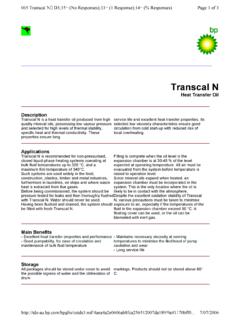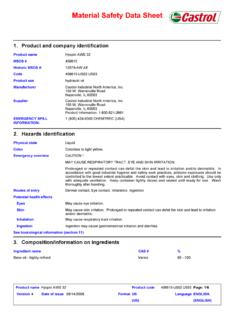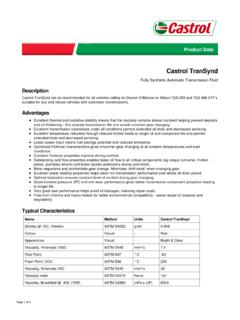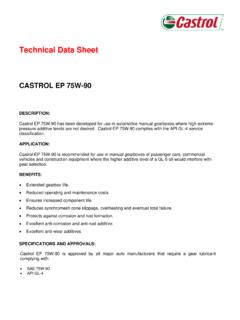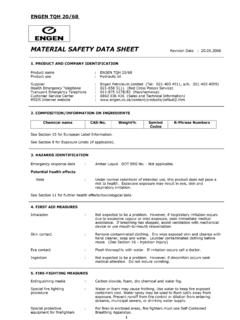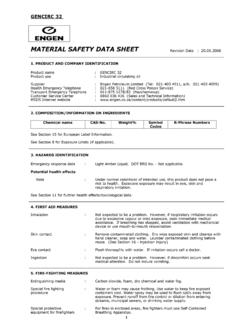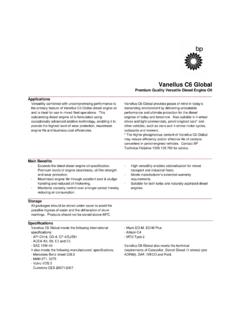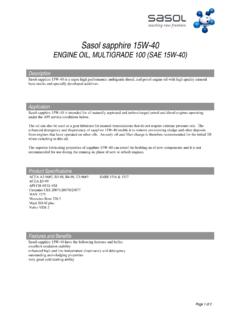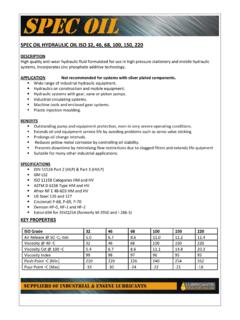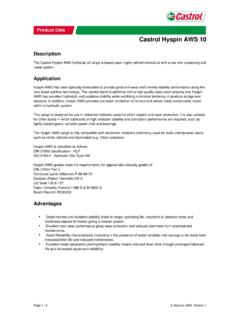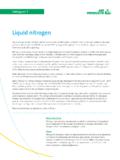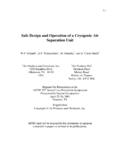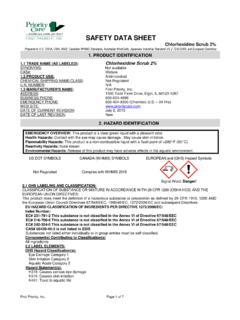Transcription of Material Safety Data Sheet - Lubricants Online
1 Material Safety data product and company identificationProduct nameALPHA SP 150 MSDS #456555 Historic MSDS #:13080-AEProduct useLubricantCode456555-US03 ManufacturerCastrol Industrial North America, W. Warrenville RoadNaperville, IL 60563 SupplierCastrol Industrial North America, W. Warrenville RoadNaperville, IL 60563 Product Information: 1-800-621-2661 EMERGENCY SPILLINFORMATION:1 (800) 424-9300 CHEMTREC (USA) on ingredientsIngredient nameCAS #% by weightDistillates (petroleum), solvent-refined heavy paraffinic (Highly refinedmineral oil)64741-88-460 - 65 Residual oils (petroleum), solvent-dewaxed (Highly refined mineral oil)64742-62-730 - identificationPhysical overviewMAY CAUSE EYE CAUSE SKIN CAUSE RESPIRATORY TRACT prolonged or repeated contact with skin.
2 Keep container closed. Wash thoroughly afterhandling. Prolonged or repeated contact can defat the skin and lead to irritation and/or with adequate ventilation. In accordance with good industrial hygiene and Safety workpractices, airborne exposures should be controlled to the lowest extent !Dermal contact. Eye contact. Inhalation. of entryPotential health effectsEyesMay cause eye cause skin irritation. Prolonged or repeated contact can defat the skin and lead to irritationand/or cause respiratory tract may cause gastrointestinal irritation and of issue 06/23 : 1/6 ALPHA SP 150 ENGLISH.
3 ( ENGLISH )ProductnameProduct codeVersion3 FormatLanguageUS456555-US03 Build toxicological Information (section 11).Medical conditionsaggravated by over-exposureNone aid measuresEye contactIn case of contact, immediately flush eyes with plenty of water for at least 15 minutes. Get medicalattention if irritation contactImmediately wash exposed skin with soap and water. Remove contaminated clothing and clothing before reuse. Thoroughly clean shoes before reuse. Get medical attention ifirritation inhaled, remove to fresh air. If not breathing, give artificial respiration.
4 If breathing is difficult,give oxygen. Get medical attention if irritation NOT induce vomiting unless directed to do so by medical personnel. Never give anything bymouth to an unconscious person. Get medical attention if symptoms measuresFlash point>210 C (Open cup) of the productProducts of combustionThese products are carbon oxides (CO, CO2) (carbon monoxide, carbon dioxide).Non-explosive in the presence of the following materials or conditions: open flames, sparks andstatic discharge, heat, shocks and mechanical impacts and oxidizing media andinstructionsIn case of fire, use water fog, foam, dry chemicals, or carbon clothing (fire)Fire-fighters should wear positive pressure self-contained breathing apparatus (SCBA) and fullturnout fire/explosionhazardsMay be combustible at high precautionsPersonal protection incase of a large spillImmediately contact emergency personnel.
5 Keep unnecessary personnel away. Use suitableprotective equipment (See Section: "Exposure controls/personal protection"). Follow all firefighting procedures (See Section: "Fire-fighting measures").Splash goggles. Full suit. Boots. Gloves. Suggested protective clothing might not be sufficient;consult a specialist BEFORE handling this release measuresIf emergency personnel are unavailable, contain spilled Material . For small spills add absorbent(soil may be used in the absence of other suitable materials) scoop up Material and place in asealed, liquid-proof container for disposal.
6 For large spills dike spilled Material or otherwisecontain Material to ensure runoff does not reach a waterway. Place spilled Material in anappropriate container for disposal. Avoid contact of spilled Material with soil and prevent runoffentering surface waterways. See Section 13 for Waste Disposal and and storageHandlingAvoid prolonged or repeated contact with skin. Avoid contact with eyes. Use only with adequateventilation. Wash thoroughly after handling. In accordance with good industrial hygiene andsafety work practices, airborne exposures should be controlled to the lowest extent container tightly closed.
7 Keep container in a cool, well-ventilated area. Empty containersmay contain harmful, flammable/combustible or explosive residue or vapors. Do not cut, grind, drill,weld, reuse or dispose of containers unless adequate precautions are taken against of issue 06/23 : 2/6 ALPHA SP 150 ENGLISH.( ENGLISH )ProductnameProduct codeVersion3 FormatLanguageUS456555-US03 Build controls/personal protectionOccupational exposurelimitsControl MeasuresProvide exhaust ventilation or other engineering controls to keep the relevant airborneconcentrations below their respective occupational exposure measuresWash hands, forearms and face thoroughly after handling chemical products, before eating,smoking and using the lavatory and at the end of the working protectionEyesAvoid contact with eyes.
8 Safety glasses with side shield or chemical and bodyAvoid prolonged or repeated contact with skin. Wear suitable protective only with adequate ventilation. In accordance with good industrial hygiene and Safety workpractices, airborne exposures should be controlled to the lowest extent suitable local authorities for acceptable exposure (petroleum), solvent-refined heavyparaffinic (Highly refined mineral oil)ACGIH (United States). STEL: 10 mg/m3 15 minute(s). Form: Oil mist, mineral TWA: 5 mg/m3 8 hour(s). Form: Oil mist, mineralOSHA (United States). TWA: 5 mg/m3 8 hour(s).
9 Form: Oil mist, mineralResidual oils (petroleum), solvent-dewaxed(Highly refined mineral oil)ACGIH (United States). STEL: 10 mg/m3 15 minute(s). Form: Oil mist, mineral TWA: 5 mg/m3 8 hour(s). Form: Oil mist, mineralOSHA (United States). TWA: 5 mg/m3 8 hour(s). Form: Oil mist, mineralIngredient nameOccupational exposure limitsPhysical and chemical kg/m3 ( g/cm3) at CDensitySolubilityVery slightly soluble in hot in cold applicableViscosityKinematic: 135 to 165 mm2/s (135 to 165 cSt) at 40 CHeat of combustionNot of issue 06/23 : 3/6 ALPHA SP 150 ENGLISH.( ENGLISH )ProductnameProduct codeVersion3 FormatLanguageUS456555-US03 Build and reactivityThe product is or incompatible with the following materials: oxidizing materials, acids and not Dioxide (CO2).
10 Nitrogen oxides (NO, )None and reactivityConditions to avoidIncompatibility with varioussubstancesHazardous decompositionproductsHazardous informationChronic toxicityNo component of this product at levels greater than is identified as a carcinogen by ACGIHor the International Agency for Research on Cancer (IARC). No component of this productpresent at levels greater than is identified as a carcinogen by the National ToxicologyProgram (NTP) or the Occupational Safety and Health Act (OSHA).No component of this product at levels greater than is classified by established regulatorycriteria as a component of this product at levels greater than is classified by established regulatorycriteria as a reproductive component of this product at levels greater than is classified by established regulatorycriteria as teratogenic or testing has been performed by the considerationsWaste informationAvoid contact of spilled Material and runoff with soil and surface waterways.
